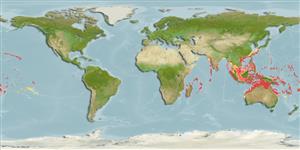Common names from other countries
>
Acanthuriformes (Surgeonfishes) >
Acanthuridae (Surgeonfishes, tangs, unicornfishes) > Acanthurinae
Etymology: Acanthurus: Greek, akantha = thorn + Greek, oura = tail (Ref. 45335).
More on author: Fowler.
Environment: milieu / climate zone / depth range / distribution range
Ecología
marino; salobre asociado a arrecife; rango de profundidad 0 - 119 m (Ref. 58302), usually 5 - 70 m (Ref. 27115). Tropical; 24°C - 27°C (Ref. 27115); 23°N - 29°S, 32°E - 124°W
Indo-Pacific: East Africa, including the Mascarene Islands (Ref. 37792) to the Hawaiian, Marquesan, and Ducie islands, north to southern Japan, south to Rapa (Austral Islands). The Indian Ocean population is without the white caudal fin.
Tamaño / Peso / Age
Maturity: Lm ? range ? - ? cm
Max length : 27.0 cm TL macho / no sexado; (Ref. 3145)
Espinas dorsales (total) : 9; Radios blandos dorsales (total) : 23 - 26; Espinas anales: 3; Radios blandos anales: 23 - 26. Body uniformly brown to dark brown; caudal fin pale in color (snow white in live fishes). Small, dark spot below and adjacent to axil of pectoral fin. Anterior gill rakers 15-18; posterior 14-16. Snout length 7.9 to 8.2 times in SL. Least depth of caudal peduncle 2.2 to 2.5 times in head length (Ref 9808).
This occasionally schooling species occurs in steep outer reef slopes and drop-offs (Ref. 1602, 48637). Benthopelagic over coral and sand (Ref. 58302). Feeds on zooplankton, particularly large gelatinous forms, and on fish eggs and crustaceans (Ref. 1920). Minimum depth reported taken from Ref. 128797.
Life cycle and mating behavior
Maturities | Reproducción | Spawnings | Egg(s) | Fecundities | Larva
Randall, J.E., 1956. A revision of the surgeonfish genus Acanthurus. Pac. Sci. 10(2):159-235. (Ref. 1920)
IUCN Red List Status (Ref. 130435)
CITES (Ref. 128078)
Not Evaluated
Threat to humans
Harmless
Human uses
Pesquerías: comercial; Acuario: Comercial
Herramientas
Special reports
Download XML
Fuentes de Internet
Estimates based on models
Preferred temperature (Ref.
115969): 24.6 - 28.8, mean 27.6 (based on 1218 cells).
Phylogenetic diversity index (Ref.
82804): PD
50 = 0.5000 [Uniqueness, from 0.5 = low to 2.0 = high].
Bayesian length-weight: a=0.02344 (0.01103 - 0.04981), b=2.96 (2.79 - 3.13), in cm Total Length, based on LWR estimates for this Genus-body shape (Ref.
93245).
Nivel trófico (Ref.
69278): 3.6 ±0.41 se; based on food items.
Resiliencia (Ref.
120179): Alto, población duplicada en un tiempo mínimo inferior a 15 meses (Preliminary K or Fecundity.).
Fishing Vulnerability (Ref.
59153): Low vulnerability (17 of 100).
